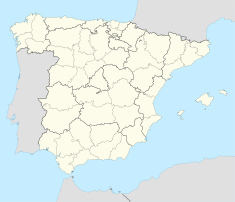
La Fortaleza, also known as the Palacio de Santa Catalina, is the official residence and workplace of the governor of Puerto Rico. Located in the historical district of Old San Juan in the capital municipality of San Juan, it has served as the governor’s residence since the 16th century, making it the oldest executive mansion in continuous use in the New World. Built from 1533 to 1540 by orders of King Charles I of Spain, the structure was the first fortification constructed by the Spanish on San Juan Islet to defend San Juan Bay, the harbor of Old San Juan. La fortaleza, alongside El Morro, San Cristóbal, El Cañuelo, and other forts part of the Walls of Old San Juan, protected strategically and militarily important Puerto Rico, or La Llave de las Indias, from invasion by competing world powers and harassment by privateers and pirates during the Age of Sail. It was designated a World Heritage Site in 1983.
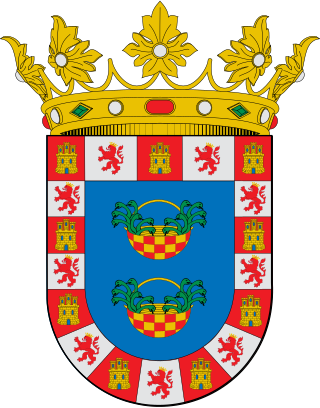
Duke of Medina Sidonia is a peerage grandee title of Spain in Medina-Sidonia, holding the oldest extant dukedom in the kingdom, first awarded by King John I of Castile in 1380. They were once the most prominent magnate family of the Andalusian region, the best-known of whom, Don Alonso Pérez de Guzmán y Sotomayor, 7th Duke of Medina Sidonia, commanded the Spanish Armada at the end of the 16th century. The defeat at the hands of weather and the English in 1588 brought disgrace to this family. The House of Medina Sidonia traces its descent from Alonso Pérez de Guzmán.

Vélez-Málaga is a municipality and the capital of the Axarquía comarca in the province of Málaga, in the Spanish autonomous community of Andalusia. It is the most important city in the comarca. Locally it is referred to as Vélez. Vélez-Málaga is the headquarters of the Commonwealth of Municipalities of Costa del Sol-Axarquía. The municipality forms part of the Costa del Sol region.

Almadraba is an elaborate and ancient technique for trapping and catching Atlantic bluefin tuna.
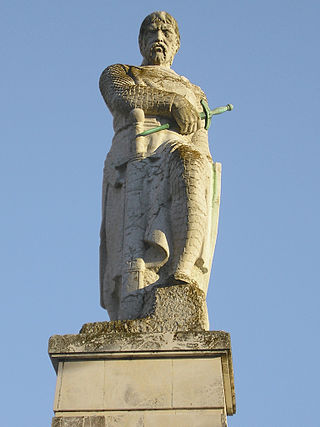
Alonso Pérez de Guzmán (1256–1309), known as Guzmán el Bueno, was a Spanish nobleman and hero of Spain during the medieval period. Guzmán is the progenitor of the Dukes of Medina Sidonia, the oldest extant dukedom in the Kingdom of Castile.

The House of Medina Sidonia is a Spanish noble house originating from the crown of Castile, whose name comes from the Duke of Medina Sidonia, a hereditary noble title that John II of Castile granted to Juan Alonso Perez de Guzman, 3rd Count of Niebla, on February 17, 1445, as a reward for his services to the crown. The Dukedom of Medina Sidonia is the oldest hereditary dukedom in the kingdom of Spain.
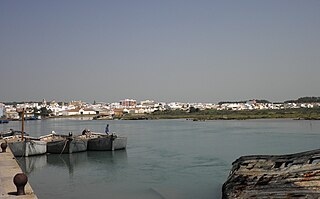
Barbate is a Spanish municipality in the Province of Cádiz, in the autonomous community of Andalusia. It is a coastal town located on the shores of the Atlantic Ocean, close to the Strait of Gibraltar. Covering a total area of 142.17 km2, it has, as of 2019, a registered population of 22,518.

The Alcazaba is a palatial fortification in Málaga, Spain, built during the period of Muslim-ruled Al-Andalus. The current complex was begun in the 11th century and was modified or rebuilt multiple times up to the 14th century. It is one of the best-preserved alcazabas in Spain. The Alcazaba is also connected by a walled corridor to the higher Castle of Gibralfaro, and adjacent to the entrance of the Alcazaba are remnants of a Roman theatre dating to the 1st century AD.

Zahara de los Atunes is a village on the Costa de la Luz of Spain in the province of Cádiz and the autonomous region of Andalusia. It is noted for its excellent beaches, an outdoor cinema, and la Iglesia Del Carmen church where, curiously, tuna were butchered and salted. Also in the town are excellent facilities including a variety of restaurants, cafes and hotels.

Sos del Rey Católico is a historic town and municipality in the Cinco Villas comarca, province of Zaragoza, in Aragon, Spain.

The Ozama Fortress, also formerly known as the city wall's Homage tower, is one of the surviving sections of the Walls of Santo Domingo, which is recognized by UNESCO as being the oldest military construction of European origin in the Americas. It was built between 1502–1508 by the Spanish at the entrance to Santo Domingo's Ciudad Colonial, Dominican Republic, and overlooking the Ozama River. Named after this river, the castle, also referred to as "La Fortaleza" or "The Fortress". It was declared by UNESCO as a World Heritage Site, together with the other historical monuments of the Ciudad Colonial.

The Palace of the Kings of Navarre of Olite or Royal Palace of Olite is a castle-palace in the town of Olite, in Navarre, Spain. It was one of the seats of the Court of the Kingdom of Navarre, since the reign of Charles III "the Noble" until its conquest by Castile (1512).
Surely there is no king with a more beautiful castle or palace and with so many gilded rooms (...) it could not say or even could imagine how magnificent and sumptuous is this palace (...)
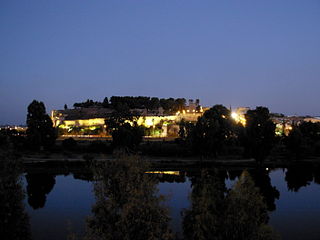
The Alcazaba of Badajoz is an ancient Moorish citadel in Badajoz, Extremadura, western Spain. The alcazaba as it now appears was built by the Almohads in the 12th century, although it probably existed from the 9th century, when Badajoz was founded. In the 11th and 12th centuries it was the residence of the rulers of the taifa of Badajoz.

The Castle of Portel is a medieval castle located in the municipality of Portel in the district of Evora in Portugal.

Old Town of Cáceres is a historic walled city in Cáceres, Spain.

The Castle of Ayora is located at an elevation of 552 (1,811 ft) metres above mean sea level (mamsl), in the centre of Ayora, a Valencian town. Built probably in the mid 13th century, after the Reconquista, on an ancient Arabian building. The architectural ensemble was composed of the four-storey residence-palace, two fortified towns, and one large keep, as well as other rooms for the soldiers and serfdom, aljibes and gardens. This was surrounded by around 0.62 miles of defensive walls and defensive towers.

Mattanza, literally 'slaughter' or 'killing' in Italian, also known as almadraba in Spanish and almadrava in Portuguese, is a traditional tuna fishing technique that uses a series of large nets to trap and exhaust the fish.

